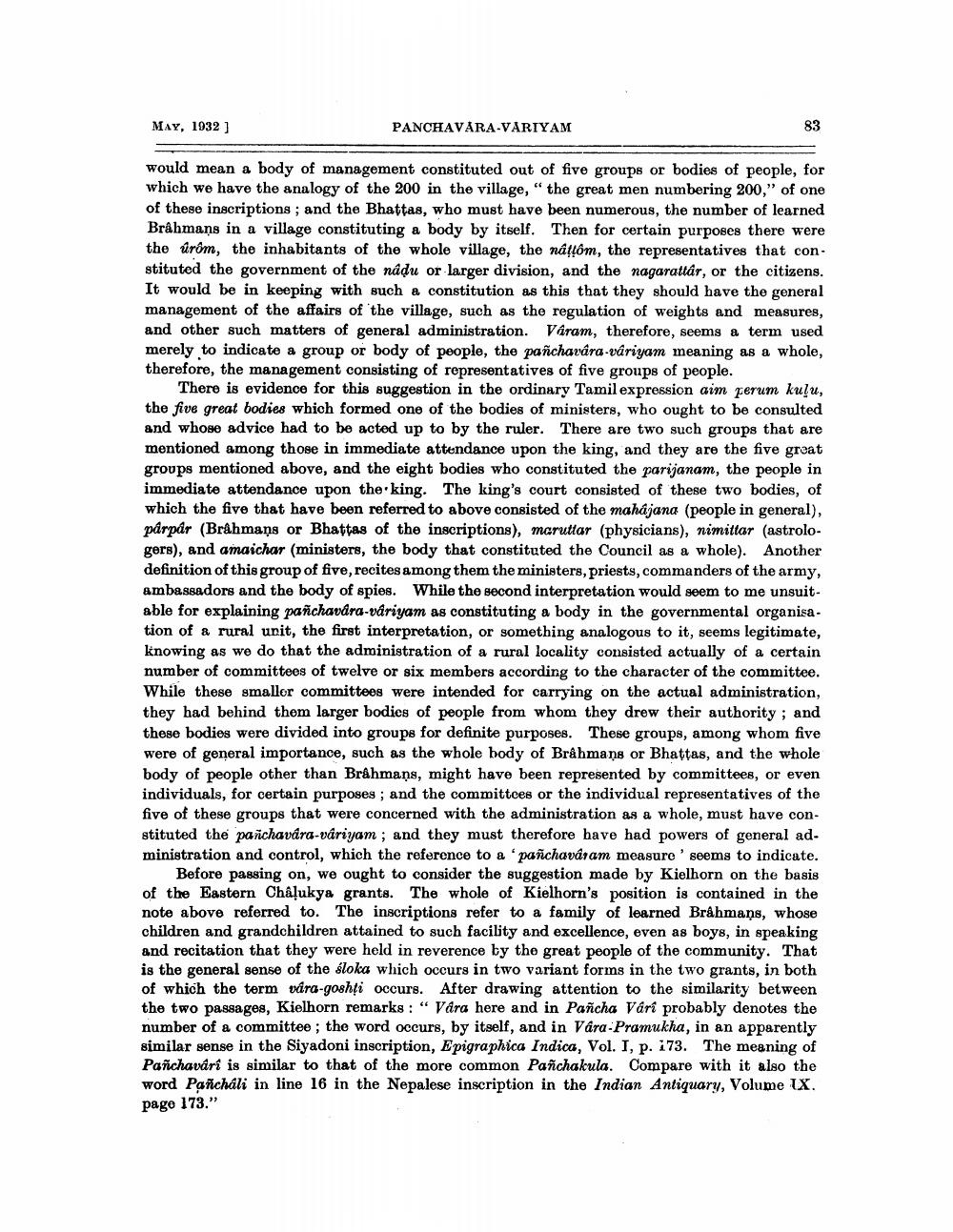________________
MAY, 1932 ]
PANCHAVARA-VARIYAM
would mean a body of management constituted out of five groups or bodies of people, for which we have the analogy of the 200 in the village," the great men numbering 200," of one of these inscriptions; and the Bhattas, who must have been numerous, the number of learned Brahmans in a village constituting a body by itself. Then for certain purposes there were the úrôm, the inhabitants of the whole village, the natôm, the representatives that constituted the government of the nadu or larger division, and the nagarattár, or the citizens. It would be in keeping with such a constitution as this that they should have the general management of the affairs of the village, such as the regulation of weights and measures, and other such matters of general administration. Varam, therefore, seems a term used merely to indicate a group or body of people, the pañchavara-váriyam meaning as a whole, therefore, the management consisting of representatives of five groups of people.
There is evidence for this suggestion in the ordinary Tamil expression aim perum kulu, the five great bodies which formed one of the bodies of ministers, who ought to be consulted and whose advice had to be actod up to by the ruler. There are two such groups that are mentioned among those in immediate attendance upon the king, and they are the five great groups mentioned above, and the eight bodies who constituted the parijanam, the people in immediate attendance upon the king. The king's court consisted of these two bodies, of which the five that have been referred to above consisted of the mahajana (people in general), párpár (Brahmans or Bhattas of the inscriptions), maruttar (physicians), nimittar (astrologers), and amaichar (ministers, the body that constituted the Council as a whole). Another definition of this group of five, recites among them the ministers, priests, commanders of the army, ambassadors and the body of spies. While the second interpretation would seem to me unsuitable for explaining pañchavara-variyam as constituting a body in the governmental organisa. tion of & rural unit, the first interpretation, or something analogous to it, seems legitimate, knowing as we do that the administration of a rural locality consisted actually of a certain number of committees of twelve or six members according to the character of the committee. While these smallor committees were intended for carrying on the actual administration, they had behind them larger bodies of people from whom they drew their authority; and these bodies were divided into groups for definite purposes. These groups, among whom five were of general importance, such as the whole body of Brahmans or Bhattas, and the whole body of people other than Brâhmans, might have been represented by committees, or even individuals, for certain purposes; and the committees or the individual representatives of the five of these groups that were concerned with the administration as a whole, must have constituted the panchavara-vdriyam; and they must therefore have had powers of general ad. ministration and control, which the reference to a 'pañchaváram measure' seems to indicate.
Before passing on, we ought to consider the suggestion made by Kielhorn on the basis of the Eastern Châļukya grants. The whole of Kielhorn's position is contained in the note above referred to. The inscriptions refer to a family of learned Brahmans, whose children and grandchildren attained to such facility and excellence, even as boys, in speaking and recitation that they were held in reverence by the great people of the community. That is the general sense of the sloka which occurs in two variant forms in the two grants, in both of which the term vara-goshți occurs. After drawing attention to the similarity between the two passages, Kielhorn remarks: "Våra here and in Pancha Vári probably denotes the number of a committee; the word occurs, by itself, and in Vara-Pramukha, in an apparently similar sense in the Siyadoni inscription, Epigraphica Indica, Vol. I, p. 173. The meaning of Panchavári is similar to that of the more common Panchakula. Compare with it also the word Panchali in line 16 in the Nepalese inscription in the Indian Antiquary, Volume IX. page 173."




